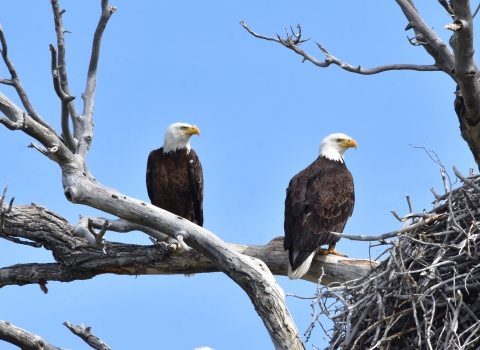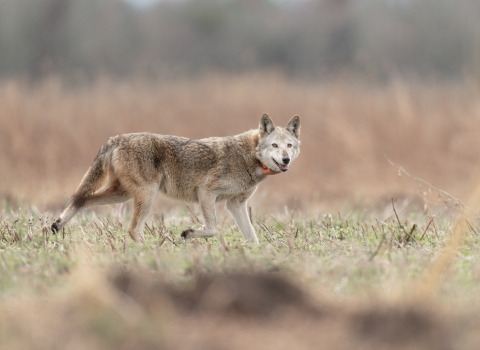A plant once only known to Puerto Rico and Saba Island, a municipality of the Netherlands, is on a path to recovery. Since its listing as an endangered species under the Endangered Species Act (ESA) in 1994, additional populations of Mitracarpus polycladus have been found on the island of Anegada in the British Virgin Islands.
Based on a review of the best scientific and commercial information available, including analyses of threats and populations, the U.S. Fish and Wildlife Service is proposing to reclassify the species from endangered to threatened.
“With increased attention to the needs of this plant and proactive survey efforts, we are able to share more good news about the status of this plant,” said Leopoldo Miranda-Castro, the Service’s Regional Director for the South Atlantic and Mississippi Basins. “Our partners have assisted us with increased habitat conservation and scientific survey efforts, bringing us to a point where we are able to say that this plant is in much better shape now than when it was first listed under the Endangered Species Act.”
Of the current estimated 20,000 plants, approximately 89% occur in areas managed for conservation. Threats due to habitat modification and destruction resulting from urban development are greatly reduced in these areas. The remaining 11% occur on private property where they are more vulnerable to threats from urbanization and development.
Ongoing threats to the species include habitat destruction and modification due to road and trail maintenance, trampling by humans, human-caused fires, non-native invasive species invasive species
An invasive species is any plant or animal that has spread or been introduced into a new area where they are, or could, cause harm to the environment, economy, or human, animal, or plant health. Their unwelcome presence can destroy ecosystems and cost millions of dollars.
Learn more about invasive species , urbanization, development for tourism, and the effects of climate change climate change
Climate change includes both global warming driven by human-induced emissions of greenhouse gases and the resulting large-scale shifts in weather patterns. Though there have been previous periods of climatic change, since the mid-20th century humans have had an unprecedented impact on Earth's climate system and caused change on a global scale.
Learn more about climate change . To mitigate threats, the Service conducts surveys and monitors natural populations, taking steps to minimize the impact of non-native grasses, and establishing firebreaks to protect the species and its habitat.
Multiple partners have been working with the Service on recovery efforts for the plant, including the Puerto Rico Department of Natural and Environmental Resources (PRDNER) and the Royal Botanic Gardens (Kew), in collaboration with the National Park Trust of the Virgin Islands. The Service will continue to work with PRDNER and private landowners and other partners on the monitoring and surveying of unexplored M. polycladus habitat to develop sound conservation strategies and proactively identify priority areas for conservation.
With this proposed downlisting, the Service is also proposing a 4(d) rule. For a threatened species, the Service may use the flexibility provided under the ESA’s section 4(d) to tailor take prohibitions to those that provide conservation benefits for the species – referred to as a 4(d) rule. This targeted approach can reduce ESA conflicts by allowing some activities to continue that may benefit and not significantly harm M. polycladus, while focusing efforts on the threats that slow the species’ recovery. These customized protections minimize the regulatory burden while maximizing the likelihood of recovery for threatened species. The proposed 4(d) rule for M. polycladus would apply the prohibitions for endangered plants (50 CFR 17.61) with standard exceptions to the prohibitions to allow partners to work with cultivated seeds on recovery actions.
The Service will accept comments on this proposed rule at www.regulations.gov (search for docket number FWS-R4-ES-2021-0058) until August 22, 2022. Requests for public hearing must be received by August 8, 2022 at the address listed below.
FOR FURTHER INFORMATION CONTACT: Edwin Muñiz, Field Supervisor, U.S. Fish and Wildlife Service, Caribbean Ecological Services Field Office, P.O. Box 491, Boquerón, Puerto Rico 00622; telephone: (787) 851-7297. Persons who use a telecommunications device for the deaf (TDD), may call the Federal Relay Service at (800) 877-8339.
For more information, please visit our Frequently Asked Questions.
The mission of the U.S. Fish and Wildlife Service is working with others to conserve, protect, and enhance fish, wildlife, plants, and their habitats for the continuing benefit of the American people. For more information on our work and the people who make it happen, visit www.fws.gov. Connect with our Facebook page atwww.facebook.com/usfwssoutheast, follow our tweets at www.twitter.com/usfwssoutheast, watch our YouTube Channel at http://www.youtube.com/usfws and download photos from our Flickr page at http://www.flickr.com/photos/usfwssoutheast.


